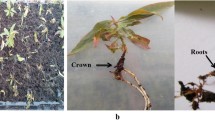Abstract
Among 153 isolates ofRhizoctonia spp. obtained from 95 soil samples collected from different fields in the USA, 42 (27.5%) isolates were hypovirulent or non-pathogenic on cabbage (tested on tap water agar plus 250 μg/ml chloramphenicol plates). Of these, 14 (33.3% of the np-R) isolates protected >60% of the cabbage seedlings againstR. solani, and the best eight isolates protected 73–95% of the cucumber seedlings. The np-R isolates RU56-8 (AG-P) and RU89-1 [AG-B(o)] induced the highest resistance against hypocotyl challenge inoculation with virulentR. solani (38.3–85.7%), whereas most of the challenged control seedlings (85–100%) collapsed. Similarly, isolates RU56-8 and RU89-1 induced the highest resistance (22.2–87.5%) against hypocotyl challenge inoculation withPythium aphanidermatum, whereas most of the challenged control seedlings collapsed (90–100%). Isolates RU56-8 and RU89-1 significantly reduced the lesion numbers and area/leaf (to 8.9–42.0% of the control) caused by challenge inoculation of the first true leaves withPseudomonas syringae pv.lachrymans. No np-R isolate could be recovered from the upper hypocotyls or from the leaves, indicating that there was no contact between the inducer and the pathogen. Root colonization with some np-R increased seedling tolerance to low soil moisture levels.
Similar content being viewed by others
References
Boosalis, M.G. and Scharen, A.L. (1959) Methods for microscopic detection ofAphanomyces euteiches andRhizoctonia solani and for isolation ofRhizoctonia solani associated with plant debris.Phytopathology 49:192–198.
Burpee, L.L. and Goulty, L.G. (1984) Suppression of brown patch disease of creeping bentgrass by isolates of non-pathogenicRhizoctonia spp.Phytopathology 74:692–694.
Cardoso, J.E. and Echandi, E. (1987) Nature of protection of bean seedlings fromRhizoctonia root rot by a binucleateRhizoctonia-like fungus.Phytopathology 77:1548–1551.
Castanho, B., Butler, E.E. and Shepperd, R.S. (1978) The association of ds-RNA withRhizoctonia decline.Phytopathology 68:1511–1519.
Harris, A.R. (1994) Plant growth promotion and biological control of damping off in container-grown seedlings using soil bacteria and fungi.Proc. 3rd Int. Workshop on Plant Growth-Promoting Rhizohacteria (Adelaide, S. Australia), pp. 18–23.
Harris, A.R., Schisler, D.A, Neate, S. and Ryder, M.H. (1993) Suppression of damping off caused byRhizoctonia solani and growth promotion in bedding plants by binucleateRhizoctonia spp.Soil Biol. Biochem. 25:263–268.
Harris, A.R., Schisler, D.A. and Ryder, M.H. (1993) BinucleateRhizoctonia isolates controlPvthium ultimum var.sporangiiferum and promote growth inCapsicum andCelosia seedlings in pasteurized potting medium.Soil. Biol. Biochem. 25:909–914.
Herr, L.J. (1988) Biocontrol ofRhizoctonia crown and root rot of sugar beet by binucleateRhizoctonia spp. andLatiseria arvalis.Ann. Appl. Biol. 113:107–108.
Herr, L.J. (1995) Biological control ofRhizoctonia solani by binucleateRhizoctonia spp. and hypovirulentR.solani. Crop Prot. 14:179–187.
Ichielevich-Auster, M, Sneh, B., Koltin, Y. and Barash, I. (1985) Pathogenicity, host specificity and anastomosis groups ofRhizoctonia spp. isolated from soils in Israel.Phytoparasitica 13:103–112.
Ichielevich-Auster, M., Sneh, B., Koltin, Y. and Barash, I. (1985) Suppression of damping off caused byRhizoctonia spp., by non-pathogenicR. solani.Phytopathology 75:1080–1084.
Louter, J.H. and Edgington, L.V. (1990) Interaction of cross-protection against Fusarium crown and root rot of tomato.Can. J. Plant Pathol. 12:283–288.
Nelsen, C.E. and Safir, G.R. (1982) Increased drought tolerance of mycorrhizal onion plants caused by improved phosphorus nutrition.Planta 154:407–413.
Sneh, B. (1996) Non-pathogenic isolates ofRhizoctonia spp. (np-R) and their role in biological control, pp. 473–483.in: Sneh, B., Jabaji-Hare, S., Neate, S. and Dijst, G. [Eds.]Rhizoctonia Species: Taxonomy, Molecular Biology, Ecology, Pathology and Disease Control. Kluwer Academic Publishers, Dordrecht, the Netherlands.
Sneh, B. and Adams, G.C. (1996) Culture preservation methods for maintaining genetic integrityof Rhizoctonia spp. isolates, pp. 139–146.in: Sneh, B., Jabaji-Hare, S., Neate, S. and Dijst, G. [Eds.]Rhizoctonia Species: Taxonomy, Molecular Biology, Ecology, Pathology and Disease Control. Kluwer Academic Publishers, Dordrecht, the Netherlands.
Sneh, B., Ichielevich-Auster, M. and Plaut, Z. (1989) Mechanism of seedling protection induced by a hypovirulent isolate ofRhizoctonia solani.Can..J. Bot. 67:2135–2141.
Sneh, B., Ichielevich-Auster, M. and Shomer, I. (1989) Comparative anatomy of colonization of cotton hypocotyls and roots by virulent and hypovirulent isolates ofRhizoctonia solani.Can. J. Bot. 67:2142–2149.
Sneh, B., Zeidan, M., Ichielevich-Auster, M., Barash, 1. and Koltin, Y. (1986) Increased growth responses induced by a non-pathogenicRhizoctonia solani.Can. J. Bot. 64:2372–2378.
Tschen, J.S.M. and Hsue, C.C. (1995) Control ofRhizoctonia solani by means of cross protection.Abstr. Int. Symp. on Rhizoctonia, Facts and Challenges in Pathology, Taxonomy,Ecology and Disease Control (Noordwijkerhout, the Netherlands), No. P-8-9.
Villajuan-Abgona, R., Kageyama, K. and Hyakumachi, M. (1996) Biocontrol of Rhizoctonia damping off of cucumber by non-pathogenic binucleateRhizoctonia.Eur. J. PL Pathol. 102:227–235.
Villajuan-Abgona, R., Katsuno, N., Kageyama, K. and Hyakumachi, M. (1996) Isolation and identification of hypovirulentRhizoctonia isolates from soil.Eur. J. Plant Pathol. 45:896–904.
Xue, L., Brisson, L. and Jabaji-Hare, S. (1997) Activation of defense mechanisms in bean seedlings protected by non-pathogenicRhizoctonia solani.Phytopathology 87:S106 (abstr.).
Yuen, G.Y., Craig, M.L. and Giesler, L.J. (1994) Biological control ofRhizoctonia solani on tall fescue using fungal antagonists.Plant Dis. 78:118–123.
Author information
Authors and Affiliations
Corresponding author
Rights and permissions
About this article
Cite this article
Sneh, B., Ichielevich-Auster, M. Induced resistance of cucumber seedlings caused by some non-pathogenicRhizoctonia (np-R) isolates. Phytoparasitica 26, 27–38 (1998). https://doi.org/10.1007/BF02981263
Received:
Revised:
Issue Date:
DOI: https://doi.org/10.1007/BF02981263




